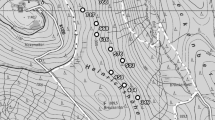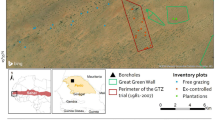Abstract
Elk (Cervus elaphus) populations in Rocky Mountain National Park are higher than at any time in the past century, and heavy browsing by elk may interfere with aspen (Populus tremuloides Michx.) regneration. We used aerial photographs to identify all aspen stands within Rocky Mountain National Park, and all aspen stands within the elk winter range range (defined as 2400 to 2800 m elevation) in three portions of the adjacent Roosevelt National Forest. From this population of aspen stands, we randomly selected 57 stands for evaluation of aspen regeneration. Stands that contained stems younger than 30 years and taller than 2.5 m tall were classified as regenerating successfully. Only 20% of the aspen stands in Estes Valley contained a cohort of regenerating aspen stems, whereas 45-to-75% of aspen stands across the larger landscape of the Front Range had regenerating cohorts of aspen. Within the elk winter range of the Roosevelt National Forest, 13 of 17 aspen stands were regenerating. In the elk winter range on the east side of the Park but outside of Estes Valley, 11 of 15 aspen stands were regenerating successfully. Only a few aspen stands exist in the elk winter range on the western side of the Park, and none of the five aspen stands sampled in Kawuneeche Valley had a regenerating cohort. The lack of regeneration in Kawuneeche Valley may result from locally heavy elk use in both winter and summer. In the summer elk range at higher elevations in the Park (2800 to 3200 m), 16 of 23 stands had regenerated. At landscape scales, all locations outside of the heavily impacted Estes Valley averaged about two cohorts/stand that regenerated after the mid-1960s. All stands that lacked a regenerating cohort showed evidence of moderate-to-severe damage from elk browsing of stems. No regenerating stands showed evidence of severe browsing. We conclude that at landscape scales, regeneration within aspen stands is very common across the Front Range, except in local areas of the highest elk use where little regeneration has occurred in the past 30 years.
Similar content being viewed by others
References
Baker, W. L., Munroe, J. A., and Hessl, A. E. 1997. The effect of elk on aspen in the winter range of Rocky Mountain National Park, Colorado, USA. Ecography 20: 155–165.
Berry, J., Decker, D., Gordon, J., Heitschmidt, R., Huff, D., Knight, D., Romme, W., and Swift, D. 1997. Science-based assessment of vegetation management goals for elk winter range. Report of the Environment and Natural Resources Policy Institute, Colorado State University, Ft. Collins.
Brown, J. K. and Simmerman, D. G. 1986. Appraisal of fuels and flammability in western aspen: a prescribed fire guide. USDA Forest Service General Technical Report INT-205, Ogden.
Colorado Division of Wildlife. 1996. Elk Habitat Database. Colorado Division of Wildlife. Fort Collins.
DeByle, N. V. 1985a. Wildlife. In Aspen: Ecology and Management in the Western United States. Pp. 135–152. USDA Forest Service General Technical Report RM-119, Fort Collins.
DeByle, N. V. 1985b. Animal impacts. In Aspen: Ecology and Management in the Western United States. Pp. 115–123. USDA Forest Service General Technical Report RM-119, Ft. Collins.
Kay, C. E. 1997. Is Aspen Doomed? J. Forestry 95: 4–11.
Krebill, R. G. 1972. Mortality of Aspen on the Gros Ventre Elk Winter Range. USDA Forest Service Research Paper INT-129, Ogden.
Larkins, K. F. 1997. Patterns of elk movement and distribution in and adjacent to the eastern boundary of Rocky Mountain National Park. MA thesis, University of Northern Colorado.
Mowrer, H. T. and Shepperd W. D. 1987. Field Measurement of Age in Quaking Aspen in the Central Rocky Mountains. USDA Forest Service Research Note RM-476, Fort Collins.
Mutel, C. F. and Emerick, J. C. 1984. From Grassland to Glacier. Johnson Books, Boulder.
Olmsted, C. E. 1977. The effect of large herbivores on aspen in Rocky Mountain National Park. Ph.D. dissertation, University of Colorado, Boulder.
Olmsted, C. E. 1979. The ecology of aspen with reference to utilization by large herbivores in Rocky Mountain National Park. In: North American Elk. Pp. 89–97. Edited by Boyce, M. S. and Hayden-Wing, L. University of Wyoming Press, Laramie.
Romme, W. H., Turner, M. G., Wallace, L. L., and Walker, J. S. 1995. Aspen, elk, and fire in northern Yellowstone National Park. Ecology 76: 2097–2106.
Romme, W. H., Turner, M. G., Gardner, R. H., Hargrove, W. W., Tuskan, G. A., Despain, D. G., and Renkin, R. A. 1997. A rare episode of sexual reproduction in aspen (Populus tremuloides Michx.) following the 1988 Yellowstone fires. Natural Areas J. 17: 17–25.
Shepperd, W. D. 1981. Stand characteristics of Rocky Mountain aspen. Situation Management of Two Intermountain Species (Aspen and Coyotes) Symposium Proceedings. Vol. I. Aspen. Utah State University, Logan.
Shepperd, W. D. 1991. Vegetative reproduction and early clonal growth of aspen. The Ph.D. dissertation, Colorado State University, Fort Collins.
Shepperd, W. D. and Fairweather, M. L. 1994. Impact of large ungulates in restoration of aspen communities in a southwestern Ponderosa pine ecosystem. In Sustainable Ecological Systems: Implementing an Ecological Approach to Land Management. Pp. 344–347. Edited by Covington, W. W. and DeBano, L. F. General Technical Report RM-247, Fort Collins.
Sokal, R. and Rohlf, F. J. 1981. Biometry. Freeman, San Francisco.
Stohlgren, T. J., Chong, G. W., Kalkhan, M. A., and Schell, L. D. 1997a. Rapid assessment of plant diversity patterns: A methodology for landscapes. Ecol. Monit. Assessment 48: 25–43.
Stohlgren, T. J., Coughenour, M., Chong, G., Binkley, D., Kalkhan, M., Schell, L. D., Buckley, D., and Berry, J. 1997b. Landscape analysis of plant diversity. Landsc. Ecol. 12: 155–170.
Stohlgren, T., Binkley, D., Chong, G. W., Kalkhan, M. A., Schell, L. D., Bull, K. A., Otsuki, Y., Newman, G., Bashkin, M., and Son, Y. 1998. Exotic plant species invade hotspots of native plant diversity. Ecology, in press.
Turchi, G. M., Kennedy, P. L., Urban, D., and Hein, D. 1995. Bird species richness in relation to isolation of aspen habitats. Wilson Bull. 107: 463–474.
USDA Forest Service. 1982. An assessment of the forest and range land situation in the United States. Forest Resource Report #22, Washington, D.C.
Author information
Authors and Affiliations
Rights and permissions
About this article
Cite this article
Suzuki, K., Suzuki, H., Binkley, D. et al. Aspen regeneration in the Colorado Front Range: differences at local and landscape scales. Landscape Ecology 14, 231–237 (1999). https://doi.org/10.1023/A:1008062514060
Issue Date:
DOI: https://doi.org/10.1023/A:1008062514060




